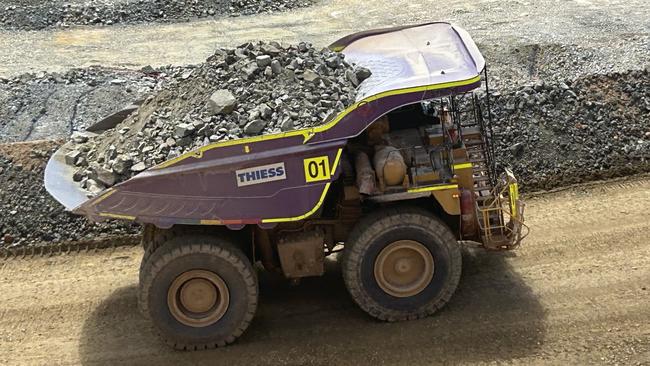Australia is being left behind on mine electrification with tax incentives needed, industry says
Tax incentives are needed to drive the electrification of Australia’s mining fleet, a high level consortium of resources companies says, while emissions targets will remain out of reach in their absence.

Tax incentives are needed to drive the electrification of Australia’s mining fleet, a high level consortium of mining companies says, arguing current policy settings lag our international peers and won’t drive the investment needed to hit the government’s emission reduction targets.
The Electric Mine Consortium also argues in a report published on Thursday, that the diesel fuel rebate disincentivises electrification, while stopping short of recommending its removal.
The group, which counts South32, Barminco, IGO and Sandfire as members, says its modelling shows that mines which convert to using electric power across their operations can operate at costs 56-88 per cent lower than their diesel-powered counterparts.
However just 60 per cent of Australian industry participants indicate that their next mining operation will transition to electric power, with high capital costs the main barrier.
“The primary barrier to adopting electric equipment, cited by 76 per cent of miners, is the high capital cost, which is rated 1.5 times more significant than the next major concern - confidence in operational effectiveness,’’ the consortium says.
“In light of these findings, the industry is urging the government to implement tax incentives to accelerate the decarbonisation of mine sites.’’
The consortium on Thursday published what is says is “the first and most extensive collaborative financial modelling exercise on mine decarbonisation undertaken in the Australian mining industry’’, which shows there are significant financial and health and safety benefits from converting from diesel to electric.
However currently in Australia, using metrics such as total cost of ownership (TCO) or net present cost (NPC), it can be difficult to make the case for investing in electrification.
“As of 2024, the financial case in Australia using either TCO or NPC is marginal using conservative assumptions,’’ the report says.
“In Canada and Europe, their models are largely positive due to public policies that directly impact the financial case.
“Government tax and regulatory incentives are less balanced towards existing fossil fuel technology, such that over 15 per cent of Sandvik’s production and demand globally is now for battery electric load and haul, equipment.
“In Australia, without this policy support, no battery electric underground haul trucks have been ordered for full operation (there are battery electric prototypes on sites).’’
The upfront capital cost for electric haul equipment is up to two times higher than diesel, the report says, while there is also operational risk given the technology is at an early stage.
Also, the report says, upside potential for low carbon commodity pricing is not typically incorporated into financial models, given the uncertainty inherent in those assumptions.
The modelling showed however, that in one case tested by the consortium, “a 5 per cent green premium on revenue is adequate to offset all of the capital investment required for electrification over the life of the mine’’.
The report argues that for mining company boards looking at the long term, “all the major risks are weighted against diesel mines’’, but there are barriers to investment right now.
“Costs in the form of volatile diesel prices, regulated carbon costs, investor preferences and portfolio targets, workforce retention, diesel particulate matter exposure class actions and social license risks are all functions of the diesel case,’’ the report says.
However volatile commodity prices have made it difficult recently to plan for the long term, posing the risk that companies lock in capital expenditure decisions which will age poorly from an emissions perspective, the report says.
The consortium’s report says Australia’s “generous” diesel tax credit, which it says will cost taxpayers $37bn from 2024-30, is a hindrance to change, as is the lack of a carbon price.
“The Australian mining industry is also not subject to a universal price on carbon, at any price, unlike Canada and Europe,’’ it says.
“The closest policy instrument is the Safeguard Mechanism, but this covers only 200 facilities in Australia, of which most are coal mines or LNG facilities.’’
The consortium is arguing in favour of capital tax incentives, such as Canada’s 30 per cent investment tax credit and its accelerated capital cost allowance, which allows accelerated depreciation, to support the take-up of electric mining.
“Indeed, there is a risk that the previously world-leading Australian mining industry will become left behind as other jurisdictions push ahead in establishing the assets and skills required for low-carbon mining,’’ the report says.
The report follow’s Andrew Forrest’s Fortescue this week announcing a $US2.8bn equipment deal with Liebherr Group, which will convert two thirds of the company’s mining fleet to zero-emissions battery technology over the next couple of years.
Fortescue says it has developed 6MW charging technology which can charge a haul truck in 30 minutes, providing six hours of run time.
Dr Forrest said electrification was “where the smart end of town is going.’’
Originally published as Australia is being left behind on mine electrification with tax incentives needed, industry says



